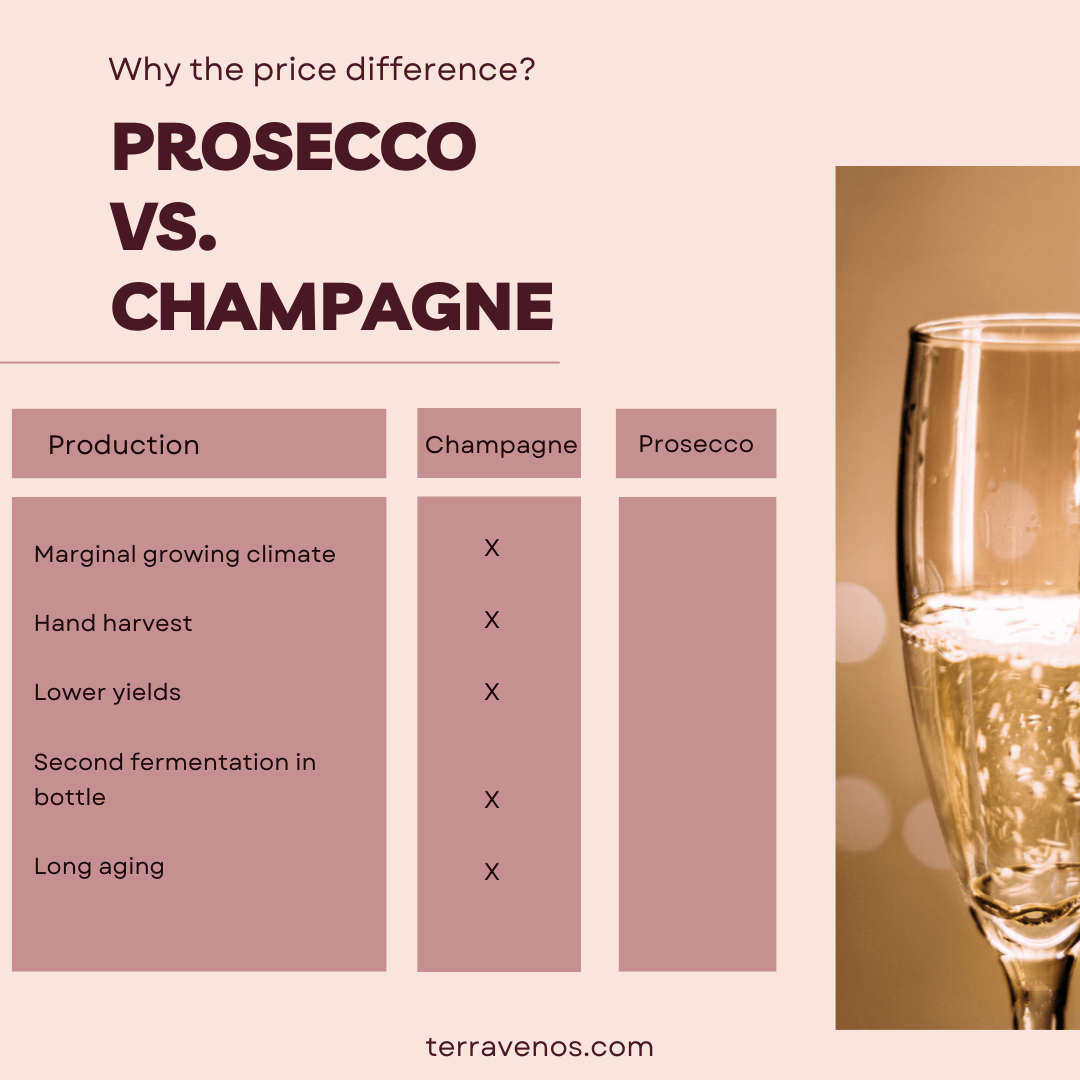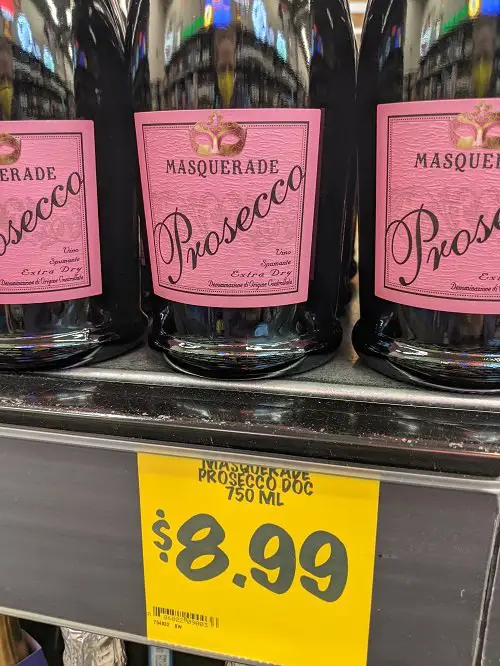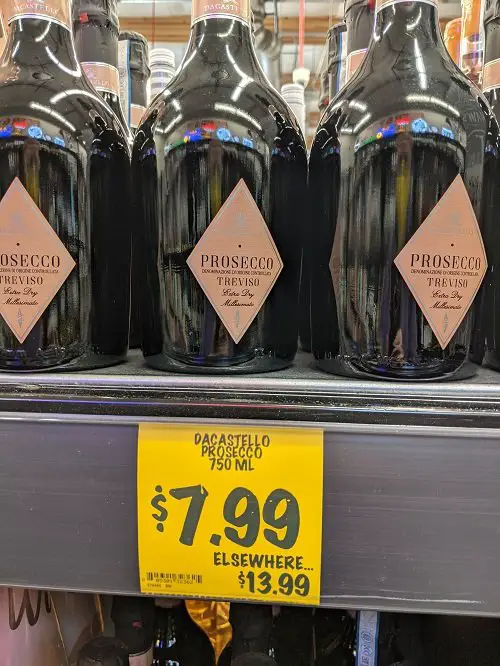
If you’ve gone shopping for a bottle of bubbly, you already know that the price difference between bottles can make your eyes pop!
The two famous sparkling wines, Prosecco and Champagne, differ in more ways than just price. Champagne’s marginal growing climate and strict regulations for limited yields, hand harvesting, and involved winemaking processes all add to production costs. Prosecco’s warmer climate, generous yields, and a modernized sparkling winemaking process mean less expensive wine with a fruitier, fresher style.
Here’s what you need to know to answer the question: Is Prosecco just cheap Champagne?
- Comparing Champagne and Prosecco Growing Climate
- Prosecco and Champagne Use Different Grapes
- Most Champagne’s Are Blends, Most Proseccos Only Uses Glera Grapes
- Champagne Has a (Much) More Complicated Production Process than Prosecco
- Why Champange Costs More than Prosecco
- Champagne Is About Winemaking Prosecco Is About the Fruit
- Is All Prosecco Cheap? Prosecco Quality Levels
- So, Is Prosecco Just Cheap Champagne? No
- Prosecco and Champagne Tasting Challenge
- Thirsty for More?
Comparing Champagne and Prosecco Growing Climate
Located east of Paris, Champagne is France’s northernmost wine growing region. Here, the cool, continental conditions create the perfect growing environment for winegrapes destined for Champagne.
The grapes maintain high levels of acidity and often barely-ripe flavors with citrus and green apple notes. These steely qualities accompany low levels of sugar that will translate into low levels of alcohol in the base wines needed for sparkling wine.
The map above centers on Épernay, a commune in the Marne department of northern France, 130 km northeast of Paris. The town is surrounded by grapevines destined for Champagne.
With late spring frosts interrupting budding and flowering leading to lower yields, along with rain throughout the growing season that can damage fruit with black rot and mildew further lowing yields, Champagne growers (of which there are some 16,000) struggle to produce consistent yields year-over-year.
Champagne growers will need to make additional passes through their vineyards with fungal sprays. This adds to costs.
Fluctuating yields mean that Champagne houses often hold onto reserve wine during good vintages that can be tapped into to cover bad vintages.
Think of this system like your own personal rainy-day fund, but with Champagne.
The Comite Champagne is a regulatory body overseeing viticulture and winemaking practices for Champagne wines. They stipulate total yields, harvest methods, harvest dates, winemaking methods, and reserve wines.
One of their main concerns is regulating Champagne’s quality and protecting the market from oversaturation that could create downward price pressure (i.e., cheaper wine).
The Comite Champagne stipulates that all grapes destined for Champagne wines must be hand harvested.Hand harvesting is labor-intensive and expensive.
As a result, Champagne grapes are some of the most expensive wine grapes around.
~50% of the price you see on a bottle of Champagne reflects grape price
Prosecco doesn’t have the challenges (or constraints) of Champagne in the vineyard.
First, grapes for Prosecco come from the warm, moderately continental plains to the north of Florence, in the Po River Valley.
Cooling air descends from the Alps helping to moderate the climate, but overall this isn’t a bad place to grow up if you’re a grape.
Check out the flat valley where grapes grown for Prosecco thrive in abundance!
The fertile sedimentary soils from the river make for reliably high yields, but lower intensity wines.
Grapes grown on hillier sites express greater concentration and fitness. Look for DOCG on your Prosecco label.
Prosecco can be machine harvested. Another plus for reducing production costs.
Prosecco and Champagne Use Different Grapes

You’ve heard of the Big 3 grapes used for Champagne:
- Chardonnay
- Pinot Noir
- Munier
Small amounts of Petit Meslier, Pinot Blanc, Arbanne, and Fromenteau can also find their way into Champagne, but the quantities are negligible.
Prosecco doesn’t use Champagne grapes.
You’ve probably never heard of the grape variety used in Prosecco: Glera (pronounced Glare-ah).
Glera is semi-aromatic (meaning it does have some fruity qualities) and super vigorous producing high yields of grapes.
Here’s a complete guide to Glera.
Most Champagne’s Are Blends, Most Proseccos Only Uses Glera Grapes
While Champagne does have its specialty bottlings, the vast majority of Champagne is a blend of the Big 3 grapes: Chardonnay, Pinot Noir, and Munier.
Champagne has a rich tradition of blending grapes together into a cuvée.
Chardonnay offers finesse and acidity. Munier brings fruity aromatics for softer, younger release wines. Pinot Noir contributes structure and backbone.
Even when the trend in dry wines is for single varietal bottlings, most Champagnes benefit from this trio of grapey characters.
Not so with Prosecco.
Glera takes the place of pride in Prosecco. Up to 15% may be a local variety, but this is rare.

Now, the producer may opt to blend different vineyard sites together for balance, and complexity, or to hit a certain pricepoint or volume, but probably the only grape in your Prosecco is Glera.
What a gal!
Champagne Has a (Much) More Complicated Production Process than Prosecco
All Champagnes go through what’s called the ‘Traditional Method’ for sparkling wine production.
Traditional Method with a capital ‘T’!
Here’s a concise video describing the complicated process of making Champagne in the traditional method:

After harvest, the grapes go through fermentation into a low-alcohol base wine.
The wine is then bottled and a small amount of yeast, sugar, nutrients, and clarifying agent get added before a crown cap (beer bottle cap) closes up the wine.
The yeast mixture, called the liqueur de tirage, starts to re-ferment in bottle over 4-6 weeks.
This is the second fermentation that adds natural CO2, or bubbles, to your sparkling wine bottle.
From this point on, the wine sits and ages with the yeast mixture inside for a minimum of 12 months, in a process called ‘sur lie’, or on the lees.
Jargon Alert: The lees refers to the dead yeast cells.
This maturation process will give the wine pastry notes, or brioche.
I often liken lees aging to an apple pie quality.
The bottles then go through a complex process of gently moving the dead yeast cells to the neck of the bottle, called riddling.
Once all of the sediment is in the neck of the wine bottle, it’s frozen in a brine solution and the bottle cap is popped off and the sedemint shoots out, leaving behind a crystal clear, bubbly Champagne.
A real Champagne cork gets added and the bottle is closed under a wire cage, called a muselet.
Whew! What a task!
Prosecco doesn’t use the ‘Traditional Method’ with a capital ‘T’.
Prosecco uses a different method, called the Charmat Method, Martinotti Method, or tank method.
The base wine starts in essentially the same way for Prosecco as for Champagne. But that’s where the similarities end.
After the primary fermentation, the wine stays in a temperature-controlled stainless steel tank or pressurized chambers, called autoclaves.
The producer adds yeast, sugar, and nutrients to the tank and seals it off to capture the CO2 from the yeast – seizing those fabulous bubbles. This secondary fermentation will last about one month.
Once the second fermentation is over, the wine may sit on the lees for a few weeks, but not long enough to impart any of those apple pie qualities – brioche, yogurt, pastry.
The producer filters off the wine under pressure and bottles it up for quick release.
The tank method allows for large volume production and can help preserve fruity qualities in your sparkling wine.
Why Champange Costs More than Prosecco

Here’s why Champagne costs more than Prosecco:
- Harder to grow the grapes in Champagne than Prosecco, Italy
- Grapes must be hand-harvest in Champagne; Prosecco can machine harvest
- Champagne regulations limit production to drive up cost
- Champagne producers have to hold onto reserves
- Champagne has a more complicated winemaker processes than Prosecco
Champagne Is About Winemaking Prosecco Is About the Fruit
Okay, this may be a controversial statement because everyone in the wine world will vouch that great wines are made in the vineyard, but hear me out…
The pride of craftsmanship in Champagne lies in the winery – from the meticulous process of adding yeast mixtures, to maturation, and disgorgement, Champagne houses work through a painstaking ritual to craft wines that showcase attention to detail in their production.
Prosecco’s linear process protects the pear, apple, and peach aromas you’ll find in your glass.
Is All Prosecco Cheap? Prosecco Quality Levels

80% of Prosecco is the inexpensive to mid-priced Prosecco DOC, but not all Prosecco wine is cheap. There is a quality ladder for Prosecco.
Given the fact that Prosecco enjoys less restrictive, more bountiful grape growing and quicker turn-around times in the winery, you’ll find yourself paying less money for Prosecco than for Champagne wines of similar quality.
Prosecco DOC
Grapes for Prosecco DOC can be sourced from anywhere in the DOC region and, again, come from fertile, high-yielding sites that make for less concentrated acceptable to good wines. Quality varies.
Think of Prosecco DOC as your everyday luxury.

Prosecco Treviso DOC and Prosecco Trieste DOC
Higher up the quality ladder, you’ll find Prosecco Treviso DOC and Prosecco Trieste DOC.

Conegliano Valdobbiadene Prosecco DOCG and Asolano Prosecco DOCG
These two Prosecco DOCG regions enjoy higher altitudes on hillier sites with cooling influences and less fertile soils to help temper Glera’s natural vigor.
Highest Quality Prosecco: Rive di Prosecco
At the top of the quality pyramid, you’ll find ‘Rive di (place name)’, which refers to a slope surrounding a commune or vineyard.
There are 43 Rive.
The grapes are hand harvested with lower maximum yields and bottlings are all vintage.
Cartizze is Prosecco’s golden vineyard.
Cartizze, a 108 hectare vineyard located in Valdobbiadene, sits on a steeply sloped hillside with excellent drainage. The wines from the Cartizze vineyard have a fuller body, with greater intensity still.
So, Is Prosecco Just Cheap Champagne? No
No, Prosecco isn’t just cheap Champagne. The two wines use different grapes, come from disparate growing climates, and have distinctive winemaking processes resulting in wholely unique sparkling wine experiences.
Prosecco and Champagne Tasting Challenge
Time to get your tasting on. Ready to try little Prosecco vs. Champagne side-by-side to taste the difference between the two?
- Champagne: Look for a non-vintage Champagne (NV on the label). Non-vintage Champagnes will be fruiter and are intended for early enjoyment (you shouldn’t sit on these bottles if you have on sitting on your wine shelf). They’ll also be less expensive than some of the more premium Champagne styles. If you’re wary of the price tag, you can often find less expensive half-bottles (375 ml), perfect for a tasting.
- Prosecco: Look for a Prosecco DOCG (you want to find the letters DOCG anywhere on the label). This will be a higher quality wine than your basic, everyday Prosecco.
Chill those bottles down and rinse the dust out of your Champagne flutes!
Thirsty for More?
Check out how to store your leftover sparkling wine here.
Here’s a quick guide to other types of sparkling wine vs Champagne. It’s confusing, I know.




